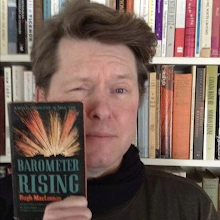Much to my dismay, this year's Globe 100 was published late last month. I thought I'd made it clear last year that November is too early. This annual round-up of the year's best books should never appear before December. How is it that a conservative newspaper is so willing to flout tradition?
 |
| Four books from the Globe's 1925 and 2025 lists. |
"It is a good year for books," writes Hammond, and yet at 110 titles the 1925 Globe list is far shorter than any previous year. For goodness sake, the 1920 list numbered 264!
How I'd love to see a photo the Book Advisor's "special nook."
(Apologies, I didn't mean that to sound filthy.)
TravelJuvenileEconomics & SociologyPoetry & DramaFiction by Canadian WritersBritish & Foreign Fiction [sic]History & BiographyReligion & TheologyEssays
Far Horizons - Bliss CarmanCanadian Singers and their Songs - Edward S. CarswellPillar of Smoke - John Crichton [Norman Gregor Guthrie]Songs of a Bluenose - H.A. CodyLow Life: A Comedy in Three Acts - Mazo de la RocheBritish Drama - Allardyce NicollLittle Songs - Majorie L.C. PickthallWayside Gleams - Laura G. SalversonThe Sea Wall - Lyon SharmonLocker Room Ballads - W. Hastings Webling
The introduction to the two fiction categories comes courtesy of C.C. Jenkins. He begins: "Glancing over the past year's lists of fiction, one is moved to the comment that, though there are a few outstanding works, [there are] none that give promise of greatness."
Dark Laughter - Sherwood AndersonManhattan Transfer - John Dos PassosAn American Tragedy - Theodore DreiserThe Great Gatsby - F. Scott FitzgeraldNo More Parades - Ford Maddox FordArrowsmith - Sinclair LewisGentlemen Prefer Blondes - Anita LoosCarry On, Jeeves - P.G. WodehouseMrs Dalloway - Virginia Woolf
Fiction is slipping back into its old groove – that of merely telling a story and telling it as well as possible – which groove, after all, may be followed with permanent success. That is what the reader has demanded in the past and what he will continue to demand in the future. 'Jazzed ' literature is but a passing phase, which has just about seen its day.
Glorious Apollo - E. BarringtonTreading the Wine Press - Ralph ConnorThe Scarlet Sash - John M. ElsonThe Golden Galleon of Caribee - Gordon Hill GrahameThe Living Forest - Arthur HemingDay Before Yesterday -Fred JacobThe High Forfeit - Basil KingBrains, Limited - Archie P. McKishniePainted Fires - Nellie McClungEmily Climbs - L.M. MontgomeryBroken Waters - Frank L. PackardThe Power and the Glory - Gilbert ParkerThe Crimson West - Alex PhilipWhen Sparrows Fall - Laura Goodman SalversonThe Laughing Birds - Archibald SullivanThe Chopping Bell and Other Laurentian Stories - M. VitorinCaptain Salvation - Frederick William Wallace
This is one of the first books I ever bought by Rev King. How is it I still haven't read it?
Nineteen-twenty-five is the pinnacle of twentieth-century English-language literature, yet as far as the Canadian is concerned, it's little more than a dead zone. The most notable novel that did not make the Globe's list is R.T.M. Scott's The Black Magician.
* When first posted, I'd written that only two titles, Wild Geese and Emily Climbs, were in print today. A reader's comment reminded me that Painted Fires was revived in 2014 by Wilfrid Laurier University Press. Thank you, Melwyk!




















































